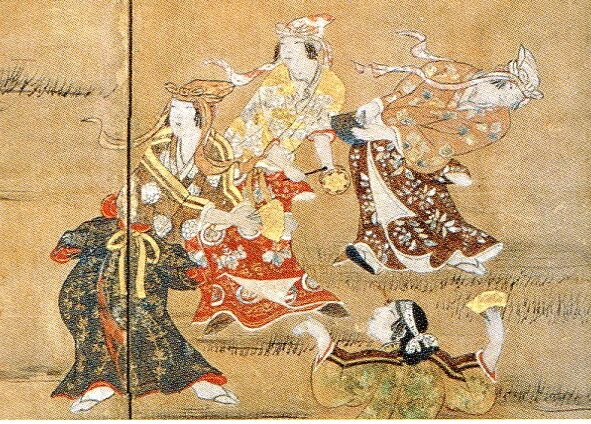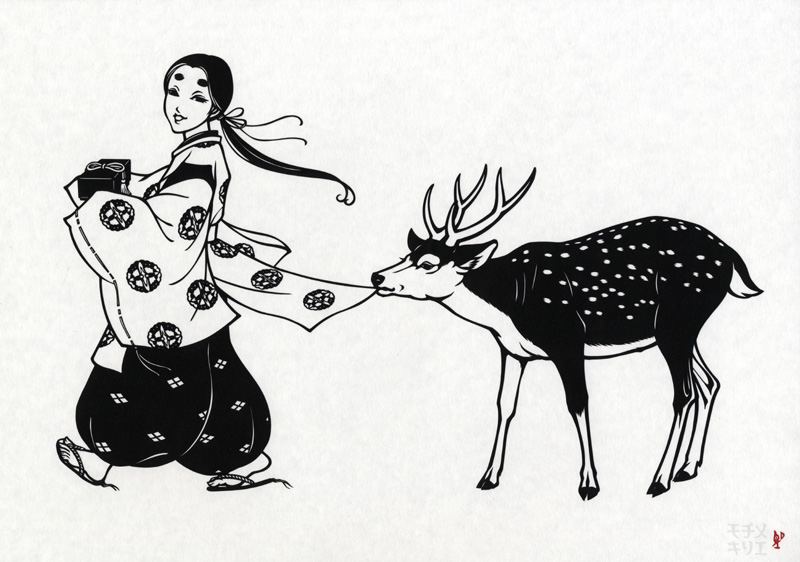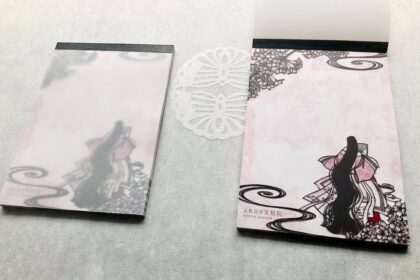The process of making papercutting
切り絵ができるまで

IDEA
着想
The encounter of a Japanese painting at an exhibition motivated me to create “Okuni Sanza”. It was a woman wearing masculine clothes with a large sword in her hand, a rosary around her neck, and casting a gaze with a strong will. Wondering who she was, I learned that she was Okuni of Izumo, the founder of Kabuki, from the title of the piece, which inspired my interest.
展覧会で出会った一点の絵画が切り絵作品「阿国山三」制作のきっかけとなりました。大太刀を手にした男勝りの格好に、 首にはロザリオ、 強い意思のあるまなざし。 いったい何者なのだろうと吸い寄せられ、タイトルから歌舞伎の創始者・出雲の阿国であると知り関心を持ちます。

While reading materials, I was increasingly attracted to her life. I went deeply into the world of energetic pictures drawn at that time, such as picture books or folding screens of Okuni Kabuki and Yujo Kabuki, feeling the passion of people. Furthermore, the composition of the Virgin Mary and angels in Christian paintings came up to mind from the possessions such as a sword and a crystal necklace, and the content of a dance, of Nagoya Sanza, a kabuki performer who is said to be the legendary lover of Okuni. From here, the images of the East and the West became connected together, which enabled me develop the idea of my work. I engraved my picture with lines of Okuni and Sanze as the core of the subject, using the technique called “Ashide” of Japanese paintings. The patterns and crests of the kimono were based on pictures of the time.
資料を読み、その生涯に惹かれていきます。 当時描かれた 阿国歌舞伎や遊女歌舞伎の絵草子や屏風のエネルギッシュな画面。 絵の世界に深く入り込み、人々の熱気を感じ取ります。 さらに、 阿国の伝説の恋人といわれる歌舞伎者・名古屋山三の、 太刀や水晶のネックレスといった持物、 踊りの内容か ら、キリスト教絵画の聖母マリアと天使の構図が頭に浮かび上がってきました。 ここから東洋と西洋のイメージが交錯し、 絵の構想が膨らんでいきます。 着物の柄や紋などは当時の絵画を参考にしています。また、主題の核となった阿国と山三のセリフを、 大和絵の葦手と呼ばれる技法で絵の中に刻み込みました。


In this manner, while linking images with materials, I constitute meticulously a view of the world. For these reasons, it takes more time to make a concept than to cut.
このように、イメージと資料をリンクさせながら作品の世界観を綿密に構築していきます。 このため、構想にかける時間のほうが彫る時間よりも長くなります。
Determination of positive and negative spaces
ネガポジの決定
I decide on the main parts where to cut or to leave while drawing a rough design. The details are determined accordingly. Before I cut, I make a decision about the location of almost all positive and negative spaces.
ラフスケッチを描きながら、切り抜く部分や残す部分など、主要な部分のネガポジを決めていきます。それに合わせて細部を決定していきます。彫り始める前におおよそのネガポジを想定しています。
Once the rough sketch is completed, it is time to trace. On the back of a black paper, I trace a design printed in reverse with a white transfer paper. In this process, the lines of the vague sketch become clear, which allows me to know the time required for cutting.
下絵が完成したらトレースをします。白い転写紙を用いて、黒い紙の裏に左右反転した図案を転写していきます。こうすることで、曖昧だった下絵の線がはっきりし、彫る作業にかかるだいたいの時間が予想できます。
Cutting
彫る
A comfortable texture of thickness of paper is a characteristic of papercutting with a flat surface. I use a knife smoothly to make every single line pleasant and alive, not to mention to make the whole picture beautiful.
平面の絵画でありながら、わずかな紙の厚みから触覚的な心地よさが伝わってくる切り絵独特の質感は、ナイフで紙を彫ることによって生まれます。絵全体の美しさはもちろん、 線の一本一本の流れが心地よく生き生きとした曲線になるように、なめらかにカットしていきます。
I work on the details first, and then I cut out large parts and easily fluffed parts of cross-section little by little. For the area I want to leave independently such as the eyes and nose, I create “connecting parts” with the contour of the face. After pasting the piece on the paper, I cut off the “connecting parts”. This technique enables me to put the parts in the right position.
まず細部から彫り始め、だんだんと切る面積の大きい部分や断面が毛羽立ちやすい部分を切り抜いていきます。 目鼻など独立して残したい部分は、輪郭と「つり」を作っておき、 台紙に貼ってから 「つり」を切りはずします。 これで微妙な位置をずらさずに貼ることができます。
Adding red
紅を差す
Basically I express my work in two colors, black and white but I also like to add red for emphasis. I cut a red paper and paste it on the back of a black paper. By the addition of red, a monotone expression stands out more.
The work is completed by applying some glue to the back of the paper I cut and fixing it to a mount.
基本的には白黒2色で表現しますが、 ポイントで赤を入れるのも好きです。 赤い紙を切って黒い紙の裏側から貼ります。 赤を少し加えることでモノトーンの表現が一層際立ちます。
切り抜いた紙の裏に糊をつけ、台紙に固定し完成です。
Collecting seeds of images
イメージの種を集める
Ideas of creation can be found at various places. I value what moves my heart or what makes my body and hands pleasant. Whenever I encounter something that touches me such as music, dance, people’s expressions I see at a festival, the view from the mountain I climb, the feel of straw sandals and casual conversations, I make a note of them. They are the important seeds of images to take out and grow when needed, even if I don’t embody them in my work right away.
制作のアイデアはいろいろなところにあります。 何に心が反応するか、体や手が喜ぶかということを大切にしています。 音楽やダンス、 祭りで見た人々の表情 、山に登って見た景色、わらじの感触、会話。心が動くものに出会うと記憶やメモにストックしておきます。 すぐに作品にしなくても、必要な時がくれば取り出して育てることができる大切なイメージの種です。

“Deer of Ohara” is the work I produced right after moving to Ohara in Kyoto and hearing from a neighbor that deer often appeared there. Wakasa-kaido Road, where my former atelier was located, is known as the old road connecting the Sea of Japan to Kyoto. I built up some images of a scene in my mind: deer living here today must be the offspring of deer that have lived in this area for hundreds of years, and the then deer may have crossed the Wakasa-kaido, while a young boy, who went on an errand to a nearby temple, may have also walked there. These images led to the creation of this papercutting.
「大原の鹿」は、 京都大原に越してすぐ、 鹿がよく現れると近所の方に聞き作品にしました。 以前の工房があった若狭街道は日本海と京都をつなぐ道として古くから知られています。今ここに住む鹿たちは、きっと何百年も昔からこのあたりで暮らしてきた鹿の子孫。 その昔の鹿も、 若狭街道を横切ったかもしれない・・ ・そのとき、 近くのお寺にお使いに来たお稚児さんが歩いていたかもしれない・・・そんな想像が膨らんでこの作品ができました。
Sometime I have a clear picture of scene from the beginning, and sometimes I get to know the shape as I move my hand.
最初から情景がはっきり浮かんでいることもあるし、手を動かしながら形が見え てくることもあります。

The theme of this work is a poem by Riga, poet of the Tang dynasty of China, beginning with “The pearl sprite has landed from the castle in the blue sky.” The first thing came to mind was an image of a pearl sprite holding a large pearl and celestial nymphs performing music lightly. When I finished to draw the girl having a pearl, she seemed to sit on something , but I didn’t know what it was. As I drew lines moving my hand, the shape of a turtle appeared, which made me perceive that the stage of this picture was in the sea, and gave birth to a new concept of plankton as food for jellyfish and pearl oysters.
After finishing the sketch and starting cutting, I was surprised to learn that the motifs were connected to each other, as if they sprang up, creating a composition that represented like the cycle of life.
Although I don’t know what I am producing now, pursing a beautiful picture, I realize that some meanings emerge and then a story comes into being. It is the best part of my work to touch this wonder of creation and depth.
この作品のテーマは唐の詩人李賀の「真珠小娘 青廓より下り」ではじまる時です。 最初に大きな珠を抱く真珠の精霊の姿と、軽やかな音楽を奏でる天女のイメージが浮かびました。 丸い球を抱えた少女を描くと、何かの上に座っているようですが、それが何かはわかりません。 手の動くまま線を引くうちに亀の姿が現れ、そこからこれは海の中だと気がつき、クラゲや真珠貝の餌となるプランクトンの構想が生まれました。
下絵が完成し彫る作業を始めてから、モチーフとモチーフが湧き上がるようにつながり、生命の循環を表すかのような構図になっていることに気が付き、驚きました。
今自分が何を描いているのかはわからないけれど、美しい絵を追い求めるうち、そこに何らかの意味が現われ、物語が生まれる。この創造の不思議、深みに触れることが、制作するなによりの醐味です。





